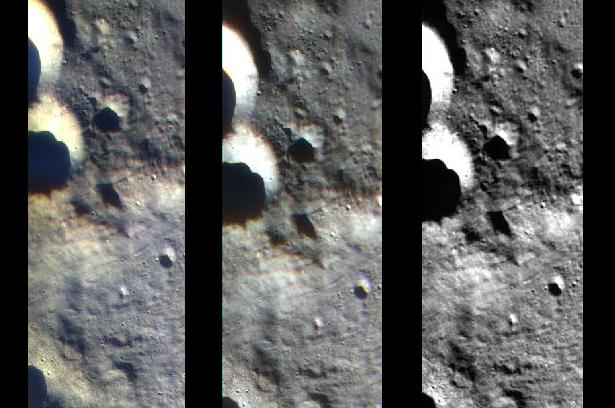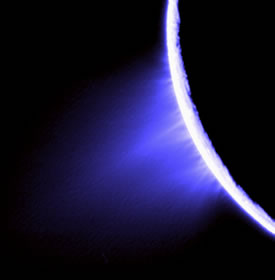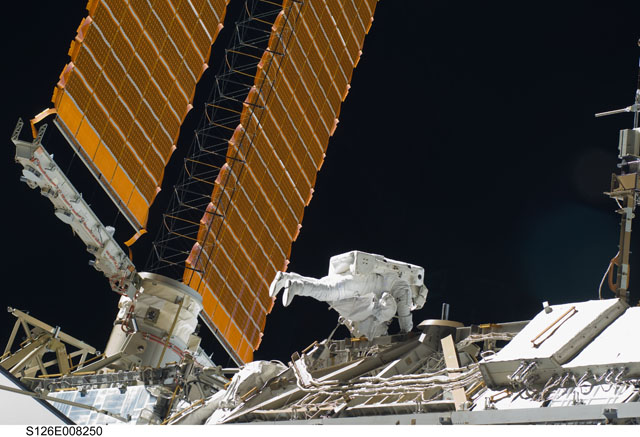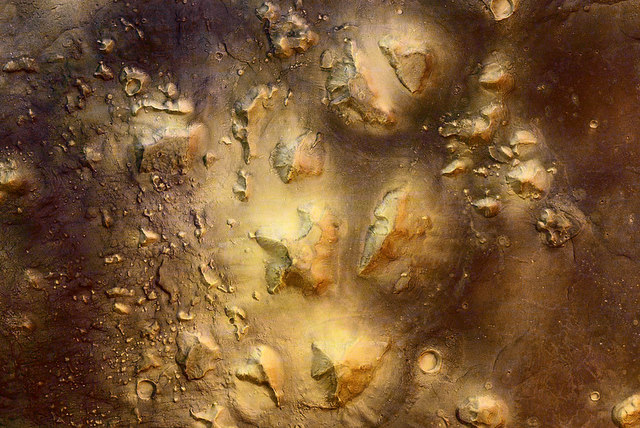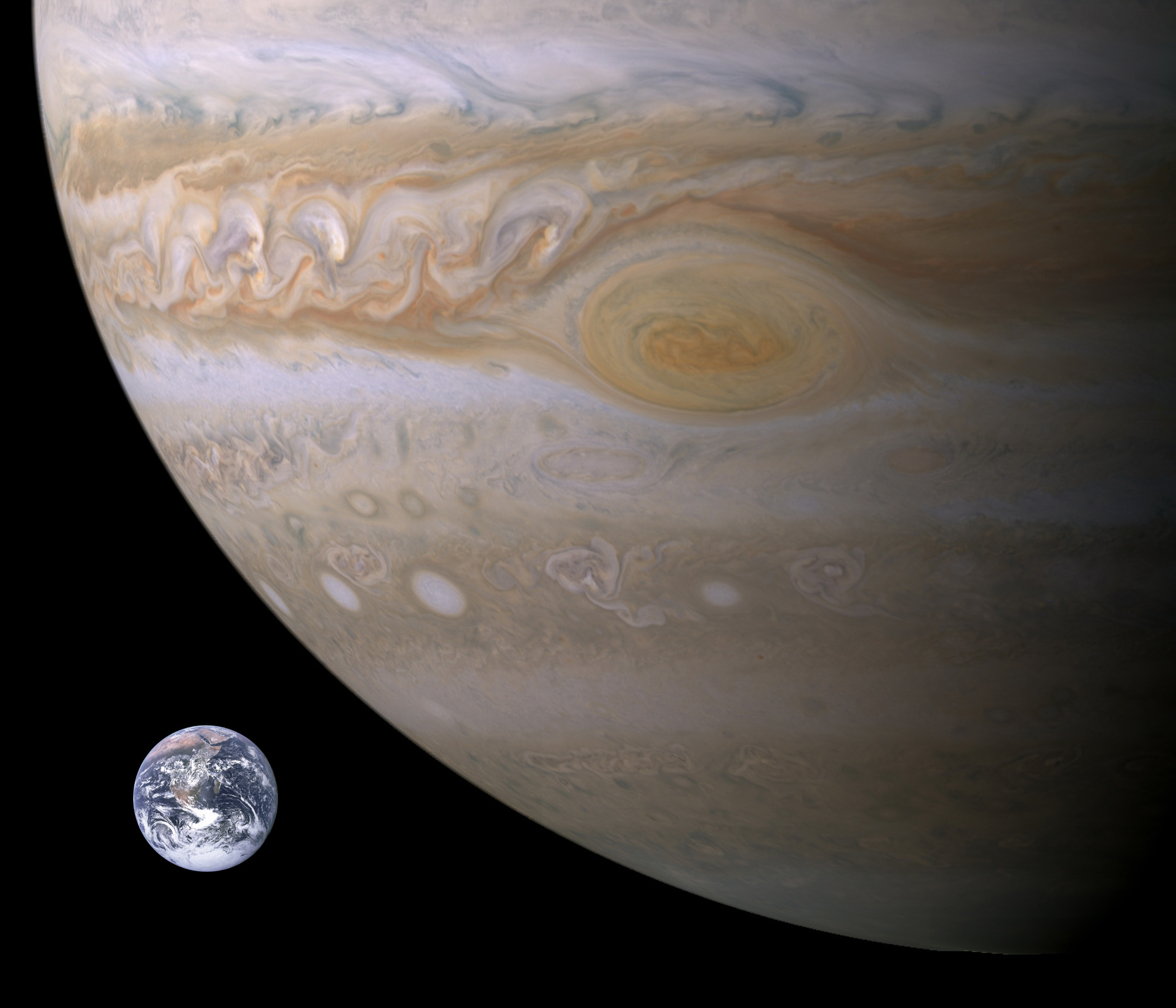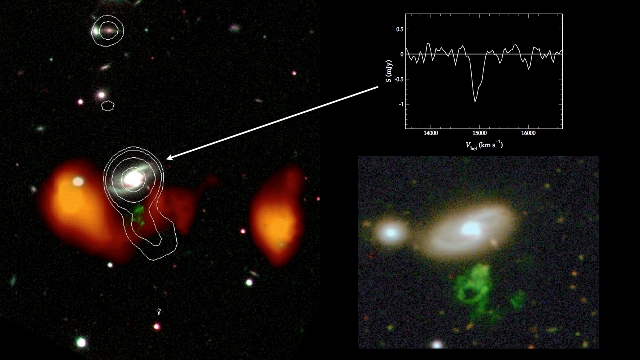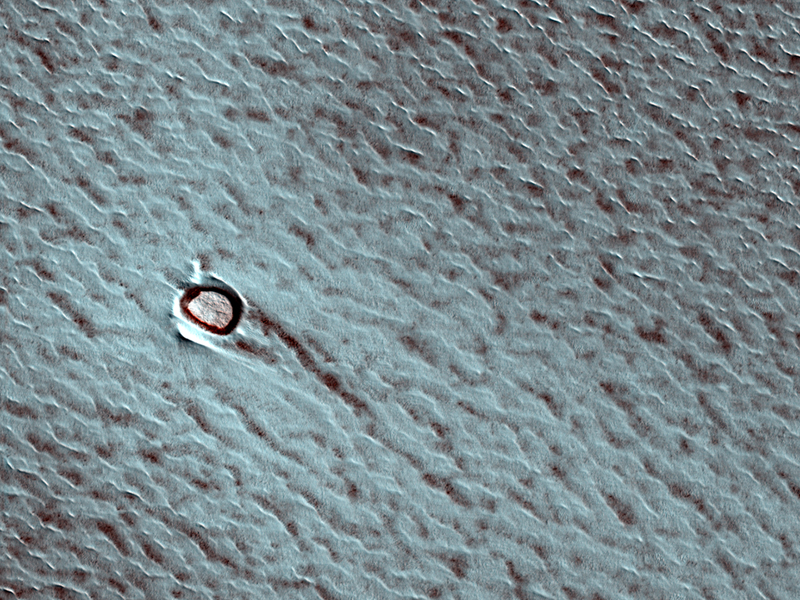Fragments of the big meteorite that lit up the Canadian skies across the provinces of Alberta and Saskatchewan last week have been found, according to a report in CBC online. University of Calgary scientists said they located several meteorite fragments late Thursday afternoon, and they were planning to take reporters to the site Friday. Planetary scientist Dr. Alan Hildebrand and graduate student Ellen Milley believe thousands of meteorite bits from the 10-ton bolide are strewn over a 20-square-kilometre area. The video above of the fireball was taken by a video camera in a police car in Edmonton, Alberta.
Continue reading “Fragments of Canadian Fireball Found”
Chandrayaan-1 Feeling the Heat
[/caption]
India’s Chandrayaan-1 spacecraft has successfully sent back some of its first science data and images from the moon, but the spacecraft is also experiencing rising temperatures, and mission managers have decided to use the instruments sparingly to avoid overheating. Chandrayaan-1 is currently orbiting over the sunlit side of the moon, and a rise in temperatures inside the spacecraft was expected, but still is a cause for concern. “This rise and fall in temperature inside a satellite is a normal cyclical process,” Mylswamy Annadurai, project director of Chandrayaan-I, told a newspaper in India, The Indian Express. “There is nothing unusual about it. But since this is the first cycle being faced by Chandrayaan, we are being extra cautious. We have decided to wait till the temperatures dip to bring the mission into the operational phase.” As of now, all but two of the instruments onboard have been switched on and tested. But only one instrument at a time is being used, and the two inactive instruments won’t be turned on until engineers know spacecraft is cool enough.
But scientists released a very nice video from the Terrain Mapping Camera…
Here’s a link to the movie of images stitched together for a view of flying over the Moon. The videos at ISRO only works in Internet Explorer. Find the science images at ISRO’s site here.
During the current orbital phase the spacecraft is almost continually in the sun and experiencing ‘summer.’ The Moon also radiates heat as it receives energy from the sun. The spacecraft’s temperature is expected to stabilize by the end of December. Until then, scientists will use one instrument at a time, but hope to operate all instruments simultaneously by mid-January.
Chandrayaan-1 has a heater, which is capable of increasing the temperature during the ‘winter’ but there is no cooling mechanism. If temperatures start reaching the upper limit, there would be no option but to switch off all the instruments.
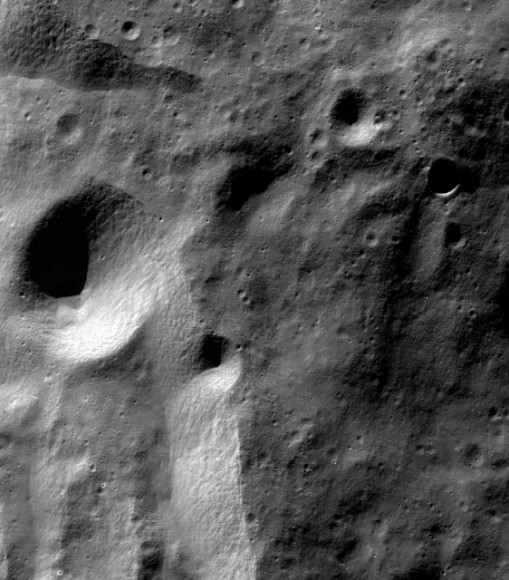
The two instruments that haven’t been turned on yet are not only more sensitive to heat but also to high voltage. One is the Swedish sub-atomic reflecting analyzer (SARA), which will image the Moon’s permanently shadowed polar regions. The other is the Indian X-ray spectrometer, HEX, which will study radioactive emissions from the lunar surface.
“We thought it would be wise to wait for the temperature to go down before testing them,” Annadurai said. The extra-cautiousness on the part of mission scientists is only because this is Chandrayaan’s first experience with such phenomenon. “We are well within the upper limit of the spacecraft’s temperature bracket. But we want to remain in this comfort zone as it is our first experience,” Annadurai added.
Chandrayaan-1 carries 11 payloads, including a Terrain Mapping Camera (TMC), Hyper Spectral Imager (HySI), Lunar Laser Ranging Instrument (LLRI), High Energy X-ray Spectrometer (HEX), Moon Impact Probe (MIP), Chandrayaan-1 X-ray Spectrometer (C1XS), Smart Near-IR Spectrometer (SIR-2), Radiation Dose Monitor Experiment (RADOM), Sub Kev Atom reflecting Analyser (SARA), Miniature Synthetic Aperture Radar (MiniSAR) and Moon Mineralogy Mapper (M3).
Source: Indian Express, ISRO
Underground Water Reservoirs Power Geysers on Enceladus
[/caption]
Saturn’s moon Enceladus may indeed hide an underground reservoir of water. Scientists analyzed the plumes seen spewing from the moon with the Cassini spacecraft, and found water vapor and ice. “There are only three places in the solar system we know or suspect to have liquid water near the surface,” said Joshua Colwell Cassini team scientist from the University of Central Florida. “Earth, Jupiter’s moon Europa and now Saturn’s Enceladus. Water is a basic ingredient for life, and there are certainly implications there. If we find that the tidal heating that we believe causes these geysers is a common planetary systems phenomenon, then it gets really interesting.”
Using data from Cassini’s Ultraviolet Imaging Spectrograph (UVIS), the team’s findings support a theory that the plumes observed are caused by a water source deep inside Enceladus. An Earth analog is Lake Vostok in Antarctica, where liquid water exists beneath thick ice.
Scientists suggest that in Enceladus’s case, the ice grains would condense from the vapor escaping from the water source and stream through the cracks in the ice crust before heading into space. That’s likely what Cassini’s instruments detected in 2005 and 2007, the basis for the team’s investigation.
The team’s work also suggests that another hypothesis is unlikely. That theory predicts that the plumes of gas and dust observed are caused by evaporation of volatile ice freshly exposed to space when Saturn’s tidal forces open vents in the south pole. But the team found more water vapor coming from the vents in 2007 at a time when the theory predicted there should have been less.
Instead, their results suggest that the behavior of the geysers supports a mathematical model that treats the vents as nozzles that channel water vapor from a liquid reservoir to the surface of the moon. By observing the flickering light of a star as the geysers blocked it out, the team found that the water vapor forms narrow jets. The authors theorize that only high temperatures close to the melting point of water ice could account for the high speed of the water vapor jets.
Although there is no solid conclusion yet, there may be one soon. Enceladus is a prime target of Cassini during its extended Equinox Mission, underway now through September 2010. Cassini launched from the Kennedy Space Center in 1997 and has been orbiting Saturn since July 2004.
The team’s findings are reported in the Nov. 27 issue of the journal Nature.
Source: EurekAlert
Good News and Great Pictures from STS-126
[/caption]
Seemingly, the current space shuttle mission, STS-126, has been all about two things: recycling and restoring. The crew has been working almost nonstop to get a new system that turns urine into drinking water to work correctly; and spacewalkers spent a majority of four grueling EVAs cleaning and lubricating a jammed solar-wing joint on the station’s right side. And now there’s good news to report on both fronts. The urine recycling system now seems to be working perfectly. “Not to spoil anything, but I think up here the appropriate words are ‘Yippee!'” space station commander Mike Fincke told ground controllers. Mission Control replied, “There will be dancing later.” The recycling system will be a necessity for supporting the International Space Station’s crew, which will increase from three to six in early 2009. Also essential will be enough power to support the larger crew, so having the SARJ working correctly, the Solar Alpha Rotary Joint which allows the solar arrays to track the sun, is more good news. After Endeavour astronauts worked on the giant gears and replaced bearing assemblies, initial tests found the starboard SARJ working well, with no power spikes or excessive vibrations. So, with the major hurdles on the mission being cleared, the astronauts will be able to enjoy an irradiated, freeze-dried, vacuum-packed Thanksgiving holiday meal on Thursday. And UT readers can now enjoy some of the great images from this mission in the gallery below.
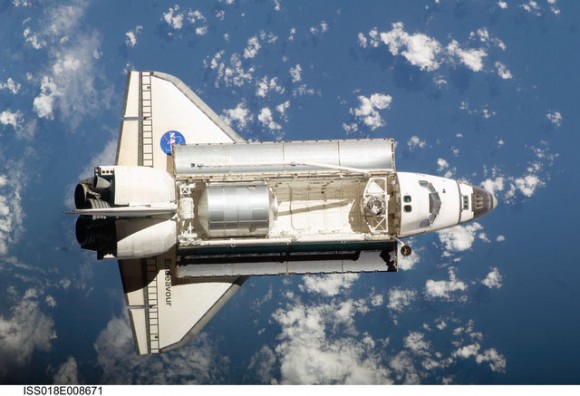
The space station crew had this view of space shuttle Endeavour as it approached the ISS for docking. Visible in the payload bay is the Italian-built Leonardo Multipurpose Logistics Module, or cargo carrier.

Fresh fruit is a rarity and a delicacy in space, and is one of the things the ISS crew enjoys the most during a shuttle visit. Here astronauts Shane Kimbrough and Sandra Magnus are pictured with fresh fruit floating freely on the middeck of Space Shuttle Endeavour.
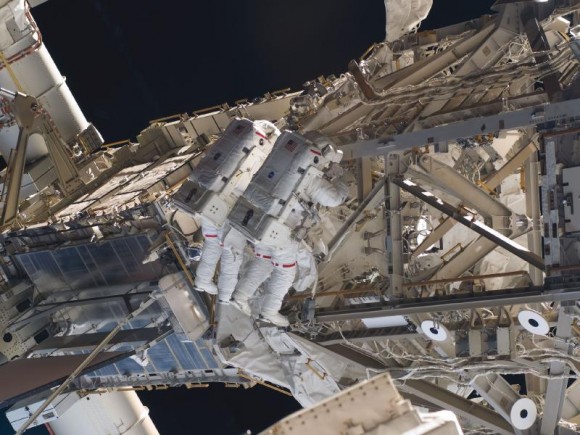
Heidemarie Stefanyshyn-Piper and Steve Bowen work in tandem near a truss structure during one of four spacewalks conducted during the STS-126 mission.
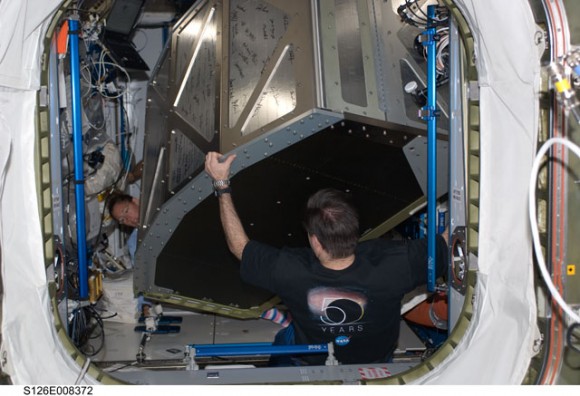
The shuttle crew brought up “home improvements” for the ISS and here, Greg Chamitoff and Sandy Magnus move a crew quarters rack in the Harmony node of the International Space Station. This will be a future crew member’s personal space and sleep station.
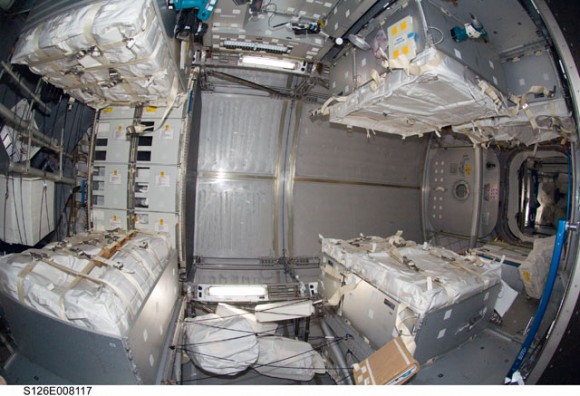
A view inside the Leonardo Multipurpose Logistics Module, which carried up 14,000 lbs of supplies and new facilities for the space station including two water recovery systems racks for recycling urine into potable water, a second toilet system, new gallery components, two new food warmers, a food refrigerator, an experiment freezer, combustion science experiment rack, two separate sleeping quarters and a resistance exercise device.
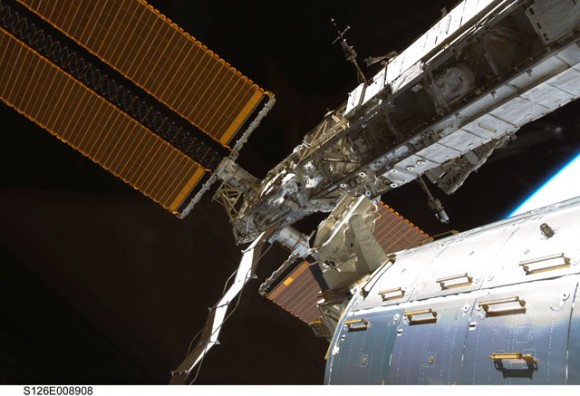
Can you find the astronaut in this image? Spacewalker Steve Bowen is dwarfed by the station components and solar arrays in this view.
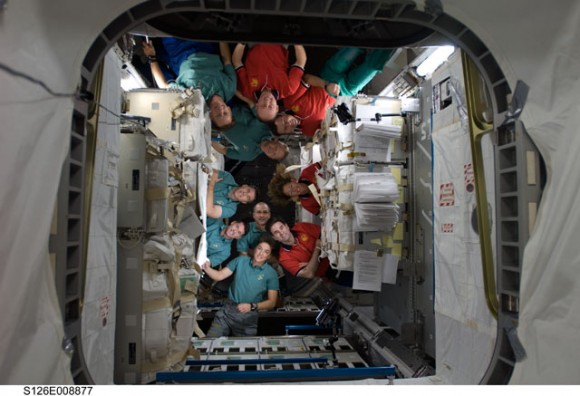
Following a space-to-Earth press conference, members of the International Space Station and Space Shuttle Endeavour crews posed for a group portrait on the orbital outpost. Astronaut Donald Pettit appears at photo center. Just below Pettit is astronaut Heidemarie Stefanyshin-Piper. Clockwise from her position are astronauts Shane Kimbrough, Steve Bowen, Eric Boe, Chris Ferguson and Michael Fincke, along with cosmonaut Yury Lonchakov, and astronauts Sandra Magnus and Gregory Chamitoff.
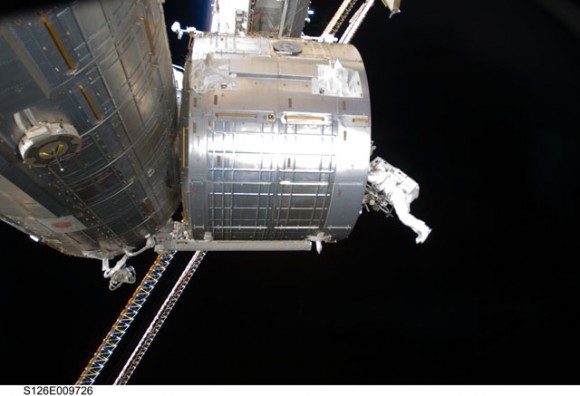
One more EVA picture for you. Here Steve Bowen works during the mission’s fourth and final EVA as maintenance continueson the International Space Station. During the six-hour spacewalk, Bowen and astronaut Shane Kimbrough (not visible), completed the lubrication of the port Solar Alpha Rotary Joints (SARJ) as well as other station assembly tasks. Bowen returned to the starboard SARJ to install the final trundle bearing assembly, retracted a berthing mechanism latch on the Japanese Kibo Laboratory and reinstalled its thermal cover. Bowen also installed a video camera on the Port 1 truss and attached a Global Positioning System antenna on the Japanese Experiment Module Pressurized Section.
See all the STS-126 images here.
Where In the Universe Challenge #31
It’s Wednesday, so that means its time for another “Where In The Universe” challenge to test your visual knowledge of the cosmos. See if you can name where in the Universe this image is from, and give yourself extra points (or some extra Thanksgiving turkey if you live in the US) if you can name the spacecraft responsible for the image. Make your guess and post a comment if you’re brave enough. I’ll try to post the answer tomorrow, depending how busy I am with the holiday festivities, so check back sometime Thursday to find the answer and see how you did. Good luck and Happy Thanksgiving!
UPDATE (11/27): The answer has now been posted below. If you haven’t made your guess yet, no peeking before you do!!
Well, the guesses posted by readers in the comments ranged from various places around the solar system, but the most frequent answer is the correct one: the Cydonia region on Mars, taken by ESA’s Mars Express. Cydonia is located in the Arabia Terra region on Mars, between the southern highlands and the northern plains of Mars. The area has several mounds of various shapes and sizes. Some over-enthusiastic folks looking at the first image of this region from NASA’s Viking 1 orbiter (1976) could see “pyramids” and a face. The “Face on Mars” can be seen in the lower right hand corner of the image above.
And here is another view of the “Face” from Mars Express. Looks more like an interesting hill, and not at all like a face.

Take a look at some more images of the region from Mars Express here.
Thanks for participating in this week’s WITU Challenge, and be sure to play again next week!
Jupiter Could Have Earth-like Rocky Core
[/caption]
Jupiter has a rocky core that is more than twice as large as previously thought, according to computer calculations by a geophysicist who simulated conditions inside the planet on the scale of individual hydrogen and helium atoms. “Our simulations show there is a big rocky object in the center surrounded by an ice layer and hardly any ice elsewhere in the planet,” said Burkhard Militzer from University of California, Berkeley. “This is a very different result for the interior structure of Jupiter than other recent models, which predict a relatively small or hardly any core and a mixture of ices throughout the atmosphere.” A comparison of this model with the planet’s known mass, radius, surface temperature, gravity and equatorial bulge implies that Jupiter’s core is an Earth-like rock 14 to 18 times the mass of Earth, or about one-twentieth of Jupiter’s total mass, Militzer said. Previous models predicted a much smaller core of only 7 Earth masses, or no core at all.
The simulation suggests that the core is made of layers of metals, rocks and ices of methane, ammonia and water, while above it is an atmosphere of mostly hydrogen and helium. At the center of the rocky core is probably a metallic ball of iron and nickel, just like Earth’s core.
“Basically, Jupiter’s interior resembles that of Saturn, with a Neptune or Uranus at the center,” he said. Neptune and Uranus have been called “ice giants” because they also appear to have a rocky core surrounded by icy hydrogen and helium, but without the gas envelope of Jupiter and Saturn.
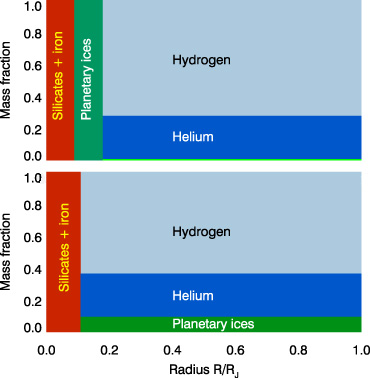
“This new calculation by Burkhard removes a lot of the old uncertainties of the 19-year-old model we have had until now,” said coauthor William B. Hubbard from the University of Arizona. “The new thermodynamic model is a more precise physical description of what’s going on inside Jupiter.”
The large, rocky core implies that as Jupiter and other giant gas planets formed 4.5 billion years ago, they grew through the collision of small rocks that formed cores that captured a huge atmosphere of hydrogen and helium.
“According to the core accretion model, as the original planetary nebula cooled, planetesimals collided and stuck together in a runaway effect that formed planet cores,” Militzer said. “If true, this implies that the planets have large cores, which is what the simulation predicts. It is more difficult to make a planet with a small core.”
In order to match the observed gravity of Jupiter, Militzer’s simulation also predicts that different parts of Jupiter’s interior rotate at different rates. Jupiter can be thought of as a series of concentric cylinders rotating around the planet’s spin axis, with the outer cylinders – the equatorial regions – rotating faster than the inner cylinders. This is identical to the sun’s rotation, Militzer said.
The researchers say their model matches up well with data from the Galileo spacecraft, which orbited Jupiter from 1995 -2003.
Militzer plans to use the new model to simulate other planets’ interiors, and to investigate the implications for the formation of planets outside our solar system. Future data from NASA’s Juno mission, to be launched in 2011 and orbit Jupiter by 2016 to measure the planet’s magnetic field and gravity, will provide a check on Militzer’s predictions.
Source: UC Berkeley
Canadian Meteor Update: 10-Ton Rock Responsible
[/caption]
The search is on for fragments of a 10-ton rock that lit the sky over western Canada last Thursday evening. Scientists estimate that at the time it hit Earth’s atmosphere, the asteroid fragment weighed approximately 10 tons and was probably about the size of a desk. It exploded with the force of 300 tons of dynamite, and hundreds of fragments of the meteorite weighing more than 50 grams (1.76 ounces) are likely strewn over a wide area. The speed of entry was relatively slow, about 14 kilometers (8.7 miles) per second, well below the average 20 kilometers (12.4 miles) per second of most meteorites, said University of Calgary researcher Alan Hildebrand. Amateur astronomers, meteorite hunters and rock hounds have been combing the prairies in western Canada for a 10-ton meteorite that lit the sky and exploded with the force of 300 tons of dynamite, according to experts from the Canadian Space Agency.
The fireball first appeared approximately 80 kilometers above and just east of the border city of Lloydminster, Alberta/Saskatchewan, and traveled SSE towards the Battle River valley fragmenting spectacularly in a series of explosions. Researchers were able to estimate it’s size and energy from infrasound recordings, said Dr. Peter Brown, Canada Research Chair in Meteor Physics at the University of Western Ontario. Infrasound is very low frequency sound produced by explosions that can travel thousands of kilometers.
“At least half a dozen infrasound stations ranging from Greenland to Utah, including Canada’s Lac Du Bonnett, Manitoba and Elgin Field, Ontario stations, recorded energy from the fireball’s explosions. The indicated energy is approximately one third of a kiloton of TNT,” Brown said.
Dr. Brown also says that a fireball this size only occurs over Canada once every five years on average. About ten fireballs of this size occur somewhere over the Earth each year.
The fireball penetrated the atmosphere at a steep angle of approximately 60 degrees from the horizontal and lasted about five seconds from 17:26:40 to 17:26:45 MST with the largest explosion at 17:26:44. The fireball was recorded on all-sky and security cameras scattered across Saskatchewan and Alberta in addition to being witnessed by tens of thousands of people who saw it streak across the sky, and may be one of the best documented meteorite falls.
But the researchers are looking for any additional information they can find.
“We are now trying to get all the transient information about the fireball before it is lost. Many motels and gas stations only keep their security recordings for one week or less, so we urge everyone to check their systems to see if they recorded the fireball or the moving shadows that it cast,” Hildebrand said. “Three gas stations and motels in Lloydminster, Lashburn and Maidstone are known to have records, but dozens of other businesses in the area probably have the fireball or its shadows recorded.”
If fireball images are found, he suggests immediately saving a copy and contacting him. “With the security camera footage we can compute the fireball’s trajectory in the sky to calculate the prefall orbit. Meteorites have only ever been recovered from known orbits nine times previously and we want to make that ten. ”
Source: PhysOrg
Sweet! Galactic Molecule Could Point to Alien Life
[/caption]
An organic sugar molecule which is directly linked to the origin of life has been detected in a region of our galaxy where habitable planets could exist. Using the IRAM radio telescope in France, an international team of scientists found the molecule in a massive star forming region of space, about 26,000 light years from Earth. “This is an important discovery, as it is the first time glycolaldehyde, a basic sugar, has been detected near a star-forming region where planets that could potentially harbour life may exist,” said Dr. Serena Viti, one of the paper’s authors. Glycolaldehyde can react to form ribose, a key constituent of the nucleic acid RNA, thought to be the central molecule in the origin of life.
Glycolaldehyde has previously only been detected near the center of our galaxy, where conditions are extreme compared to the rest of the galaxy. But its discovery in an area far from the galactic center in an area known as ‘G31.41+0.31’ suggests that the production of this key ingredient for life could be common throughout the galaxy. This is good news in our search for alien life, because a wide spread of the molecule improves the chances of its existing alongside other molecules vital to life, and in regions where Earth-like planets may exist.

Professor Keith Mason, Chief Executive of the STFC, said that “the discovery of an organic sugar molecule in a star-forming region of space is very exciting and will provide incredibly useful information in our search for alien life. Research like this, combined with the vast array of other astronomical projects involving UK researchers, is continually expanding our knowledge of the Universe and keeping the UK at the forefront of astronomy.”
Read more in the team’s abstract.
Sources: PhysOrg.com, RedOrbit
Hanny’s Voorwerp Revealed?
Ever since Hanny Van Arkel found an unusual object while scanning through images as an enthusiastic Galaxy Zoo volunteer, astronomers and astronomy enthusiasts have wondered what the bizarre object, known as “Hanny’s Voorwerp” actually is. Now, new observations made by radio telescopes may have finally revealed the nature of the Voorwerp (Dutch for “object.”) It appears as though a jet of highly energetic particles is being generated by a massive black hole at the center of IC2497, creating an ionized gas cloud.
While surfing through hundred’s of images over a year ago, Hanny, a Dutch school teacher noticed a huge green irregular cloud of gas of galactic scale, located about 60,000 light years from a nearby galaxy, IC2497. The cloud is enormous and the gas is extremely hot (> 15,000 Celsius) but paradoxically it is devoid of stars.
An international team of astronomers, led by Prof. Mike Garrett, and also Hanny van Arkel herself, have observed IC2497 and the Voorwerp with the Westerbork Synthesis Radio Telescope (WSRT) and an e-VLBI array in which the WSRT also participated.
“It looks as though the jet emanating from the black hole clears a path through the dense interstellar medium of IC 2497 towards Hanny’s Voorwerp”, says Garrett. “This cleared channel permits the beam of intense optical and ultraviolet emission associated with the black hole, to illuminate a small part of a large gas cloud that partially surrounds the galaxy. The optical and ultraviolet emission heats and ionizes the gas cloud, thus creating the phenomena known as Hanny’s Voorwerp.”
One remaining question is where does all the hydrogen gas come from? “There is a lot of gas out there – the WSRT observations detect a huge stream of gas that is extended across hundreds of thousands of light years”, says Dr. Gyula Józsa, another member of the team. According to Józsa the total mass of gas is about 5000 million times the mass of the sun. It’s something Dr. Tom Oosterloo thinks he has seen before: “It has all the hallmarks of an interacting system – the gas probably arises from a tidal interaction between IC 2497 and another galaxy, several hundred million years ago.”

Oosterloo also thinks he can identify the culprits, “the stream of gas ends three hundred thousand light years westwards of IC2497 – all the evidence points towards a group of galaxies at the tip of the stream being responsible for this freak cosmic accident”.
Hanny van Arkel, who is visiting the team at ASTRON this week is impressed. “I’m happy we are making progress. Apparently the more we learn about the Voorwerp, the more intriguing it becomes”. Garrett and his team agree – “We think the Voorwerp has a few more secrets to reveal”. The team plan much deeper observations with the WSRT and with other telescopes soon.
Source: ASTRON
Crazy Mars Craters
[/caption]
With all the different spacecraft orbiting and roving on the Red Planet, we’re finding that Mars is a wonderfully diverse and dynamic planet, with some unusual landforms. Take craters, for instance, and especially a few images of craters from the Mars Reconnaissance Orbiter’s HiRISE camera. The image above shows a small impact crater on the bright north polar ice cap, near where the Phoenix lander sits, now silently. The perennial, or permanent, portion of the north polar cap consists almost entirely of water ice, and so this curious-looking crater in the ice has never melted away. And its obvious how differently craters are formed in ice; ice ejecta just doesn’t look the same as soil! This crater is about 66 meters (215 feet) in diameter, and scientists think the slightly elliptical shape of the crater is a result of an oblique, or a sideways impact (instead of straight down.) And if you think this crater is unusual, how about a crater that looks upside down….
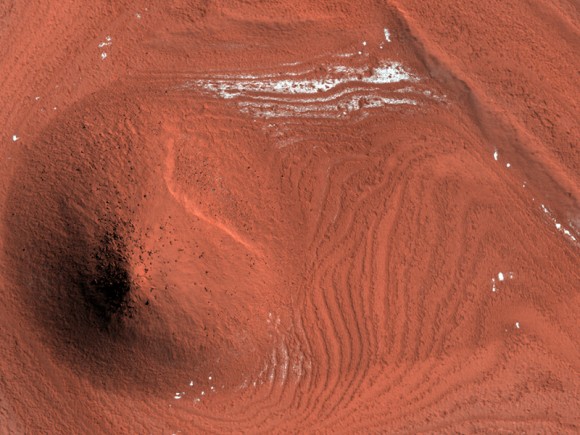
Yes, this mound may actually be a buried impact crater. “The mound may be the remnant of a buried impact crater, which is now being exhumed,” said HiRISE team member Shane Byrne, of the University of Arizona. Byrne said the crater formed as the north polar ice layers were being deposited. The crater itself would have been filled in by ice after it formed.
Most of these craters are buried under the Martian surface and inaccessible to scientists and their instruments. But this crater and its mound were exhumed as erosion formed a trough above and around it. “For reasons that are poorly understood right now, the ice beneath the site of the crater is more resistant to this erosion, so that as the trough is formed, ice beneath the old impact site remained, forming this isolated hill,” Byrne said.
At high resolution, the HiRISE image shows that the mound is made up of polygonal blocks as big as 33 feet (10 meters) across.
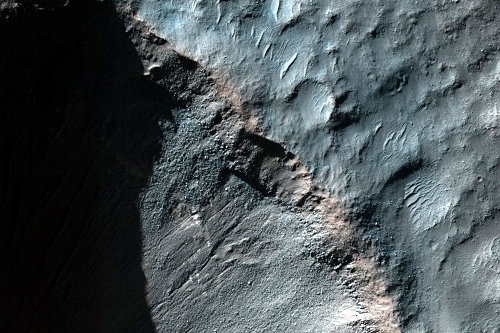
Hopefully this crater rim won’t take on monumental connotations and become known as the H on Mars, but, yes, that’s what it looks like. It’s actually just dark colored outcrops in an otherwise light colored area. You can also see gullies in the crater wall just to the left of the “H,” which scientists probably find more interesting and intriguing than the H.
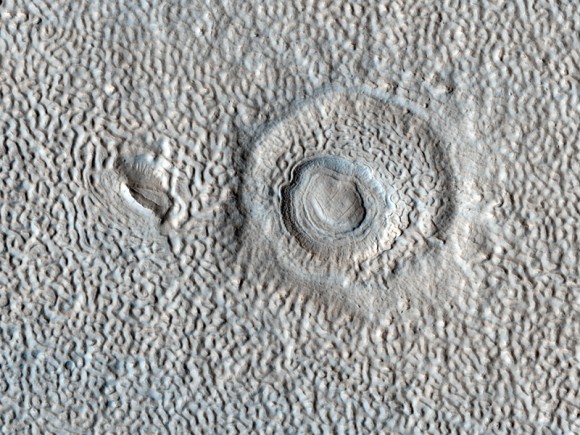
And finally, since I have craters on the brain, I’ll call this image the Grey Matter Crater. Doesn’t the texture of this region look like a brain?! Actually, these landforms in the Dueteronilus Mensae region on Mars are made up of complex alignments of small ridges and pits often called “lineated valley fill.” The cause of the texture is not well understood, but may result from patterns in ice-rich soils or ice loss due to sublimation (ice changing into water vapor).
For more HiRISE (High Resolution Imaging Science Experiment) mages, browse through the ever-interesting and ever changing HiRISE website.

